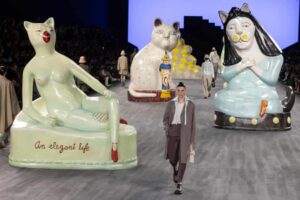
The Dior menswear designer Kim Jones has gained a reputation as a somewhat prolific collector of art and rare books. His homes are peppered with pieces by Francis Bacon and Andy Warhol, and he is the owner of the largest collection of Virgina Woolf books and letters in the world – 21,000 pieces and counting. So it’s not surprising the aesthete enjoys melding the world of art with his other great love, fashion.
For his latest spring/summer 2025 collection that he showed in Paris on Friday afternoon Jones worked with the South African ceramicist Hylton Nel. The octogenarian is best known for his plates, pots, figures and vases featuring whimsical illustrations and satirical text.
For Dior they appeared to have been put through a supersizing kiln with six gargantuan sculptures including a nonplussed-looking cat and a nude female torso fused with a feline head, dotted around the vast catwalk. Guests including Brooklyn Beckham, Kate Moss and Robert Pattinson lined up next to them to secure their shot for social media. Nel watched the whole thing unfold from his front-row seat wearing a white shirt dotted with the same sweet dog motif that appeared on the show’s invitation.
In a preview before the show Jones described the collection as less conceptual than his previous and more “wardrobe-y.” This translated into what are usually demarcated as menswear staples including double-breasted blazers, slightly cropped trousers and sturdy derby-type shoes.
The colour palette was grounded in the classic rather than the avant-garde too with muddy browns, aubergine and oatmeal shades. However, for the more adventurous there were still plenty of jaunty pieces such as apron-detail trousers and beautiful knee-length coats, some featuring shimmering embellishment, others with contrasting high-shine patent collars.
Delving into the house’s vast archives, the British designer zoned in on its founder Christian Dior’s era which ran from 1947 to 1957. This time around Jones’s approach involved “deconstructing womenswear and putting it back together as menswear”.
